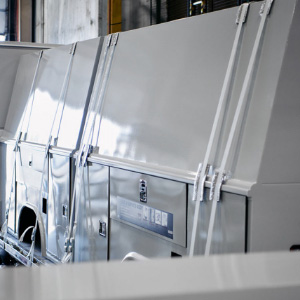Featuring James Muiter, Product Line Manager, Reading Truck Group
As we kick off a new year at Reading, we took time out to reflect on the work truck industry and a trend we’ve seen become increasingly more important – safety and security. The safety of a work crew and vehicle operators is paramount, along with securing their “office on wheels” and the equipment and tools they need to do their jobs. With this in mind, we asked James Muiter, Product Line Manager at Reading, some questions about the trends he’s observed and what he thinks will be important to watch this year and in the years to come.
Q: As you look back over the last few years what are a few specific safety and security trends you’ve observed?
A: There are definitely a few trends that come to mind as I reflect back on the last few years:
Operator safety. Increased attention to operator safety and ergonomics. Employers are carefully considering how to keep their operators injury-free and productive, so avoiding accidents around the truck is just as important as on the road. Proactive measures on a work-truck can include safety steps and grips so that the operator can maintain “three points of contact” at all times when entering and exiting the back of a work vehicle. At Reading, we’ve begun to see these concerns migrate from the very largest fleet operators and governments, into corporations and vocational fleet buyers.
Increased attention to visibility. Keeping the truck and its surroundings well-lighted and visible helps protect workers from accidents on the side of the road, and keeps crews productive when they’re working after sundown, especially in the winter months.
Increased attention to active safety. Chassis OEMs are bringing safety innovations like 360° cameras, accident-avoidance technologies like collision warning, automatic emergency braking, adaptive cruise control and blindspot monitoring, which used to be only on luxury cars, into the commercial truck segment. Every Ford Transit is now shipping with lane-departure warning and forward-collision warning camera systems.
Increased interest in protecting tools and gear. A typical work-truck now provides at least two layers of ‘locking’ protection. Compartment doors will use power locks or three-point locking for additional points of contact and pry-proofing. And these can be augmented with a “bar lock” or master locking feature, where a single padlock can secure all of the compartment doors to keep tools and equipment safe.
Q: What is a key safety/security challenge impacting the work truck industry today?
A: As the OEM’s chassis safety systems evolve, work truck equipment needs to be ready to evolve in lockstep. Body builders will be thinking about how to incorporate newer features like blind-spot sensors, 360° cameras and parking sensors, into their body and upfit designs, and in a way that integrates seamlessly with the different OEMs’ systems.
Q: What products/services/solutions have you seen in the marketplace that address the trends you’ve observed?
A: Reading’s remote keyless entry locking system, called Latch-Matic, can now be integrated with the power locks on the chassis. A driver can now lock and unlock both the body and chassis with a single key-fob. Using just the chassis fob on a Ford Super Duty or Ford Transit gives our customers the convenience they have been asking for.
Reading’s newest crane body, the Master Mechanic 20-series, includes built-in amber strobe lights to improve visibility for work crews. Based on customer demand, that’s a feature we see being added to upfits almost across the board.
For better ergonomics, handles and steps are no longer considered a special add-in, they’re becoming much more of a standard offering across the board.
Q: What suggestions or advice would you offer to a fleet manager or business owner looking to make safety upgrades to their work trucks?
A: If I have to narrow it down to just a few, here would be my main suggestions:
Four-corner strobe lights are a must for any crew that could potentially be working in proximity to traffic or on busy job sites. More than four lights are even better.
Handles and steps — preferably fixed steps that don’t have to be manually unfolded by the operator — will help meet evolving safety requirements and might even lower insurance costs.
Step surfaces should provide traction or “grip” features, like a treadplate, a pooched surface, grip struts, or a durable coating like a spray-on liner, to reduce the possibility of slip and fall injuries.
Remote-controlled LED floodlights (“go lights”) are a user-friendly way to keep crews working safely when the sun goes down, and illuminate hazards.
Q: What safety and security trends do you think will impact the industry in the next 3-5 years?
A: In the era of Coronavirus and social distancing, it’s anyone’s guess what safety protocols we’ll need to have in place, but there may well be interest in how to keep vocational crews and tradespeople productive and safe. We’ll be listening to customers to see how the work truck industry can play a role in providing mission-critical services while protecting workers and the public alike.
What I feel sure about is that the focus on ergonomics and worker safety will continue. I’m looking forward to seeing what additional advances in LED lighting technology will help keep crews productive all around the vehicle.
________________________________________
Check back on our blog or follow us on Facebook, LinkedIn and Twitter, for more Q&A sessions like this one with Reading experts on important topics and trends impacting the work truck industry.
Have a question, suggestion or some thoughts to share about Reading truck bodies? We’re happy to hear from you. Visit our contact page and we’ll be in touch.



